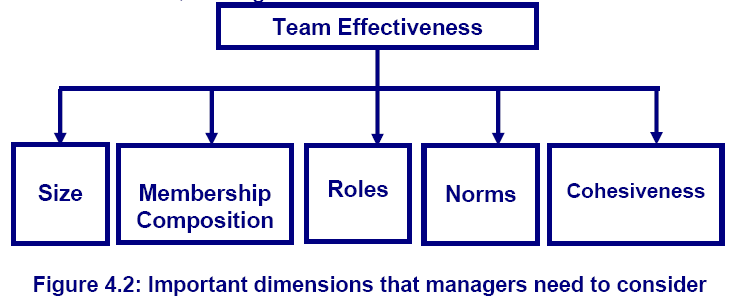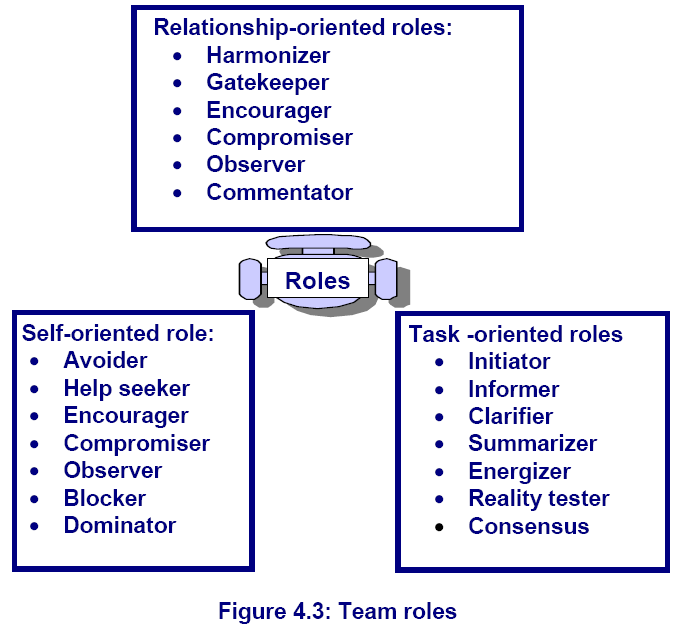|
4.2
Dimensions Influencing Team Effectiveness
 The
following is a classic listing of effective teams: The
following is a classic listing of effective teams:
Ø
Members are loyal to one another and the leader.
Ø
Members and leaders have a high degree of
confidence and trust in each other.
Ø
The group is eager to help members develop their
own potentials.
Ø
The members communicate fully and frankly all
information relevant to the team’s activities.
Ø
Members feel secure in making decisions that seem
appropriate to them.
Ø
Activities of the group occur in a supportive
atmosphere.
Ø
Group values and goals express relevant values
and goals of members.
 Q:
What are the dimensions that influence team effectiveness? Q:
What are the dimensions that influence team effectiveness?
A large number of dimensions can affect
how effectively the team functions. Here we examine five
important dimensions that managers need to consider, see Figure
4.2.
Figure 4.2: Important dimensions that managers
need to consider

 A)
Size A)
Size
Effective task groups can range from
2 members to a normal upper limit of 16.
It is difficult to pinpoint an ideal group size because
the appropriate size depends on the group’s purpose.
Size affects how individuals interact
with each other as well as the overall performance of the group.
In groups of less than five members, there will be more personal
discussion and more complete participation. As a group size
grows beyond several members, it becomes more difficult for all
members to participate effectively. Communication and
coordination among members become more difficult, and there is a
tendency to split into subgroups. As a result, the
interactions become more centralized, with few individuals
taking more active roles relative to the rest; disagreements may
occur more easily; and group satisfaction may decline unless
group members put a good effort into relationship-oriented
roles.
As group size increases,
more potential human resources are available to perform the work
and accomplish the needed tasks. While this can boost
performance, the expanded group size tends to increase turnover
and absenteeism.
 B)
Membership Composition B)
Membership Composition
Two composition factors have
particularly important influence on a group’s effectiveness, see
Table 4.1. The first factor is members’
characteristics, while the second factor is
members’ motivations.
Table 4.1: Membership composition
|
Members’ characteristics
|
Members’ motivations
|
|
It includes physical
traits, abilities, job-related knowledge and skills,
personality, age, race, and gender. |
It includes members’
motives to join a group; such as the need for power,
security, and affiliation. |
- Characteristics
- Backgrounds
- Interests
- Values
- Attitudes
- Personality
- Age
- Gender
- Race, and
- Job-related knowledge and skills
 Does
homogeneous or heterogeneous lead to more effective team? Does
homogeneous or heterogeneous lead to more effective team?
-
For
tasks that are standard and routine, a homogeneous
team functions more quickly. Membership homogeneity
contributes to member satisfaction, creates less conflict,
and increases the chance of harmonious working relationships
among group members.
-
For
tasks that are non-routine and require diverse
skills, opinions, and behaviors, a heterogeneous team yields
better results. A heterogeneous membership can bring variety
of skills and viewpoints to bear on problems and thus
facilitate task accomplishment.
 C)
Roles C)
Roles
Roles are the
many hats we wear. Roles are shared expectations of how group
members will fulfill the requirements of their positions.
People develop their roles based
on their own expectations, team’s expectations, and the
organization’s expectations.
To summarize:
-
We
may define a role as the typical behaviors that characterize
a person in a social context.
-
In
organizations, many roles are assigned by virtue of an
individual’s position within an organization. For example,
boss may be expected to give orders, and a teacher may be
expected to lecture and to give exams. These are behaviors
expected of the individual in that role.
When operating in a team, individuals
typically fulfill several roles. Members’ roles fit into three
categories, see Figure 4.3:
First:
Task-oriented roles: focus
on behaviors directly related to establishing and achieving the
goals of the group or getting the task done. They include the
following behaviors:
-
Seeking and providing information,
-
Initiating actions and procedures,
-
Clarifying issues,
-
Summarizing progress, energizing the quantity and quality of
output, and
-
Helping the team to reach consensus.
Second:
Relationship-oriented roles:
include behaviors that cultivate the well-being, continuity,
and development of the group. They focus on the operation of
the group and maintenance of good relationships among members.
They help foster group unity, positive interpersonal relations
among group members, and the development of members’ ability to
work effectively together.
Third:
Self-oriented roles:
occur to meet some personal need or goal of an individual
without regard for the group’s problems.
They often have a negative influence on
a group’s effectiveness. Examples of such behaviors include:
-
Dominating group discussions,
-
Emphasizing personal issues,
-
Interrupting others,
-
Distracting the group from its work, and
-
Wasting the team’s time.
Figure 4.3: Team roles

Roles
Ø
Role:
set of behaviors a group member is expected to perform because
of his position in the group.
Ø
In
cross-functional teams,
members perform roles in their specialty.
Ø
Managers
need to clearly describe expected roles to group members when
they are assigned to the group.
Ø
Role
making
occurs as workers take on more roles as group members.
Ø
Self-managed teams
may assign the
roles to members themselves.
 D)
Norms D)
Norms
Why do norms develop? The most important function that norms serve is to
provide regularity and predictability to behavior. This provides
implied psychological security and permits us to carry out daily
business with minimal disruption.
 Norms:
a group’s unspoken rules. Norms:
a group’s unspoken rules.
Ø
Norms may be defined as generally
agreed-upon informal rules that guide team members’ behavior.
Ø
They represent shared ways of viewing the
world. Norms differ from organizational rules in that they are
not formal and written.
Ø
Norms regulate the behavior of teams in
important ways such as how to dress, and when it is acceptable
to be late for or absent from work.
Ø
Norms can be either prescriptive –
dictating the behaviors that should be programmed- or
proscriptive – dictating the behaviors that should be avoided.
Ø
Norms are unwritten and often-informal
rules shared beliefs about what behavior is appropriate and
expected of team members.
Ø
Norms differ from organizational rules in
that they are unwritten. Team members must accept them and
behave in a way consistent with them before they can be said to
exist. This difference is important when dealing with
heterogeneous and diverse teams.
Team Norms: shared rules that
members follow may include:
ý
People dress.
ý
The upper and
lower limits of productivity.
ý
The information
that can be told to the boss.
ý
The matters
that need to remain secret.
ý
Performance
standards.
ý
Voice and body
language.
ý
Power of
distance.
ý
Teams may set
working hours, behavior rules, etc.
ý
Conformity &
Deviance: members conform to norms to obtain rewards, imitate
respected members, and because they feel the behavior is right.
When a member deviates, other members will try to make them
conform, expel the member, or change the group norms to
accommodate them. Conformity and deviance must be balanced for
high performance from the group. Deviance allows for new ideas
in the group.
Ø
If a group member does not follow the
norms, the other members will try to enforce compliance through
acceptance and friendship or through such means as punishment
and verbal abuse.
Ø
Group norms can be positive, helping the
group meet its objectives, or they can be negative, hindering
the group’s effectiveness.
Ø
Managers need to understand the norms of
the groups they manage and then work toward maintaining and
developing positive norms, while eliminating negative norms.
 E)
Cohesiveness E)
Cohesiveness
Ø
Group
cohesiveness: measures the loyalty to the group by its members.
Ø
Level of
participation: as cohesiveness rises, so will participation.
Ø
Participation
helps get members actively involved, but too much can waste
time.
Ø
Level of
Conformity: as conformity rises, so does cohesiveness.
Ø
With too much
conformity, performance can suffer.
Ø
Level of Group
Goal Accomplishment: as cohesiveness rises, the emphasis on
group accomplishment will rise.
Ø
High levels of
cohesiveness can cause the group to focus more on itself than
the firm.
Ø
Determinates
of cohesiveness can be altered to change cohesiveness levels in
a group.
Ø
Group Size:
small groups allow high cohesiveness.
Ø
Low
cohesiveness groups with many members can benefit from splitting
into two groups.
Ø
Managed
Diversity: diverse groups often come up with better solutions.
Ø
Group
Identity: when cohesiveness is low, encourage a group to adopt a
unique identity and engage in healthy competition with others.
Ø
Success:
cohesiveness increases with success.
Ø
Look for a way
for a group to find some small success.
|